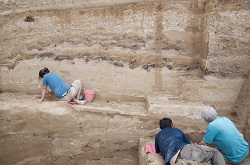Unearthing the migrations that characterise the population history of Europe
Within paleo-anthropological research, the Neanderthal replacement and the Middle to Upper Palaeolithic transition are two of the most hotly debated topics. Consensus has not yet been reached as to their timing, scale or sequence. Additionally, most research has concentrated mainly on areas of western, southern, and central Europe. To address some of these uncertainties and limitations, the EU funded NEMO-ADAP project focused its attention on western Ukraine and Russia in the investigation of the Late Middle and Early Upper Palaeolithic. The project set out to answer fundamental questions about the behavioural and cultural adaptations which enabled modern humans to disperse into Europe; whether these adaptations were unique to modern humans and to look at the prevailing climatic conditions during that dispersal. Generating newly excavated materials and datasets NEMO-ADAP selected case study regions in Ukraine and Russia because as the project coordinator, Dr. Philip R Nigst, explains, ‘They are characterised by long loess-palaeosol sequences with high palaeoclimatic resolution, providing a crucial climatic context in which Neanderthal and modern human occupations can be situated.’ Additionally, remains relating to both species were also known to be present at the selected sites. The project’s approach was highly inter-disciplinary, including specialists from the realms of archaeology and anthropology as well as geology, climate studies, mineralogy, dating studies (incl. radiocarbon) and genetics, offering what Dr. Nigst refers to as, ‘a role-model for similar projects.’ While prior interdisciplinary research had taken place, it was limited to a few sites and crucially also applied a variety of methodologies, which as Dr. Nigst summarises, ‘resulted in datasets of variably comparable quality and resolution.’ The NEMO-ADAP team conducted surveys to find new sites through the occurrence of stone tools and bone fragments on the valley slopes. Once identified, a vertical section was created to study the succession of deposits and to collect samples for Neanderthal and modern human behaviour, age estimation and the reconstruction of past environmental and climatic change. The team made a number of somewhat surprising discoveries. They found that the first appearance of modern humans and Upper Palaeolithic technologies in Eastern Europe was actually 2 000 years earlier than previously thought. As Dr. Nigst explains, ‘This means that there was an extended time of overlap between Neanderthal and modern human populations within Eastern Europe.’ Genetic and population analysis also indicate that Eastern Europe was likely colonised by what the team refer to as ‘directional, rapid dispersals’. The project also provided evidence for Neanderthal and modern human presence in Eastern Europe during the coldest and most arid climatic phases, whereas previously it had been assumed that both could only happen during the warmer climatic phases. This suggests resilience to climate change by both species, though they were unlikely to have used the same survival strategies. A Europe long characterised by migration By better understanding the dynamics of past population movements, dispersals and fusions, the study has implications for our appreciation of the formation of a European identity through its genetic and cultural heritage. As Dr. Nigst elaborates, ‘It highlights that this diversity is key for our survival and prosperity, something especially important in the light of increased migration to and within Europe.’ Additionally, the study sheds further light on our species’ responses to climate change, alongside improved comparative knowledge about how another closely related species (Neanderthals) fared under similar circumstances. Knowledge that while specific in this instance to Europe has ramifications for diverse cultures around the globe. Having generated plenty of new high-resolution data, the NEMO-ADAP project results will now be compared with Central Europe results from an earlier project, as well as with patterns of Neanderthal-Modern human replacement described by other research teams, in various parts of Europe and Western Asia.







